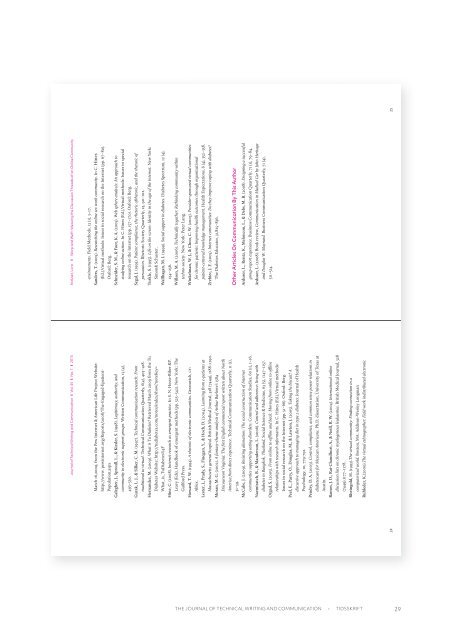Bachelor – Mediedesign NTNU Gjøvik
Min bachelor i mediedesign ved NTNU Gjøvik.
Min bachelor i mediedesign ved NTNU Gjøvik.
You also want an ePaper? Increase the reach of your titles
YUMPU automatically turns print PDFs into web optimized ePapers that Google loves.
24<br />
Journal of Technical Writing and Communication Vol. 45 No. 1 2015<br />
March 16,2009, from the Pew Internet & American Life Project Website:<br />
http://www. pewinternet.org/Reports/2008/The-Engaged-Epatient-<br />
Population.aspx<br />
Galegher, J., Sproull, L., & Kiesler, S. (1998). Legitimacy, authority, and<br />
community in electronic support groups. Written Communication, 15 (4),<br />
493<strong>–</strong>530.<br />
Gurak, L. J., & Silker, C. M. (1997). Technical communication research: From<br />
traditional to virtual. Technical Communication Quarterly, 6(4), 403<strong>–</strong>418.<br />
Hernandez, M. (2009). What is Tu Diabetes? Retrieved March 2009 from the Tu<br />
Diabetes Website: http://tudiabetes.com/notes/index/show?noteKey=<br />
What_is_TuDiabetes%3F<br />
Hine, C. (2008). Internet research as emergent practice. In S. N. Hesse-Biber &P.<br />
Leavy (Eds), Handbook of emergent methods (pp. 525<strong>–</strong>542). New York: The<br />
Guilford Press.<br />
Howard, T. W. (1994). A rhetoric of electronic communities. Greenwich, ct:<br />
Ablex.<br />
Lester, J., Prady, S., Finegan, Y., & Hoch, D. (2004). Learning from e-patients at<br />
Massachusetts general hospital. British Medical Journal, 328 (7449), 1188<strong>–</strong>1190.<br />
Moran, M. G. (2002). A fantasy-theme analysis of Arthur Barlowe’s 1584<br />
Discourseon Virginia: The first English commercial report written about North<br />
America from direct experience. Technical Communication Quarterly, 11 (1),<br />
31<strong>–</strong>59.<br />
McCabe, J. (2009). Resisting alienation: The social construction of Internet<br />
communties supporting eating disorders. Communication Studies, 60 (1), 1<strong>–</strong>16.<br />
Naemiratch, B., & Manderson, L. (2006). Control and adherence: living with<br />
diabetes in Bangkok, Thailand, Social Science & Medicine, 63 (5), 1147<strong>–</strong>1157.<br />
Orgad, S. (2005). From online to offline and back: Moving from online to offline<br />
relationships with research informants. In C. Hines (Ed.),Virtual methods:<br />
Issues in social research on the Internet (pp. 51<strong>–</strong>66). Oxford: Berg.<br />
Peel, E., Parry, O., Douglas, M., & Lawton, J. (2005). Taking the biscuit? A<br />
discursive approach to managing diet in type 2 diabetes. Journal of Health<br />
Psychology, 10, 779-791.<br />
Pendry, D. A. (2003). Control, compliance, and common sense power relations in<br />
diabetescare for Mexican Americans. Ph.D. dissertation, University of Texas at<br />
Austin.<br />
Ramos, J. D., Rai-Chaudhuri, A., & Neill, R. W. (2004). International online<br />
discussion lists on chronic myelogenous leukaemia. British Medical Journal, 328<br />
(7449),1177<strong>–</strong>1178.<br />
Rheingold, H. (1993).The virtual community: Finding connection in a<br />
computerized world. Boston, MA: Addison-Wesley Longman<br />
Ruhleder, K.(2000).The virtual ethnographer: Field work indistributed electronic<br />
Arduser, Lora Warp and Weft: Weaving the Discussion Threads of an Online Community<br />
environments. Field Methods, 12 (1), 3<strong>–</strong>17.<br />
Sanders, T. (2005). Researching the online sex work community. In C. Hines<br />
(Ed.),Virtual methods: Issues in social research on the Internet (pp. 67<strong>–</strong>80).<br />
Oxford: Berg.<br />
Schneider, S. M., & Foot, K. A. (2005). Web sphere analysis: An approach to<br />
studying online action. In C. Hines (Ed.),Virtual methods: Issues in special<br />
research on the Internet (pp. 157<strong>–</strong>170). Oxford: Berg.<br />
Segal, J. (1993). Patient compliance, the rhetoric ofrhetoric, and the rhetoric of<br />
persuasion. Rhetoric Society Quarterly, 23, 90<strong>–</strong>102.<br />
Turkle, S. (1995). Life on the screen: Identity in the age of the Internet. New York:<br />
Simon& Schuster.<br />
Wallhagan, M. I. (1999). Social support in diabetes. Diabetes Spectrum, 12 (4),<br />
254<strong>–</strong>256.<br />
Willson, M. A. (2006). Technically together: Rethinking community within<br />
techno-society. New York: Peter Lang.<br />
Winkelman, W. J., & Choo, C. W. (2003). Provider-sponsored virtual communities<br />
for chronic patients: Improving health outcomes through organizational<br />
patient-centered knowledge management. Health Expectations, 6 (4), 352<strong>–</strong>358.<br />
Zrebiec, J. F. (2005). Internet communities: Do they improve coping with diabetes?<br />
The Diabetes Educator, 31,825<strong>–</strong>836.<br />
Other Articles On Communication By This Author<br />
Arduser, L., Rentz, K., Meloncon, L., & Debs, M. B. (2008). Designing a successful<br />
group-report experience. Business Communication Quarterly, 71 (1), 79<strong>–</strong>84.<br />
Arduser, L. (2008). Book review, Communication in Medical Car by John Heritage<br />
and Douglas W. Maynard. Business Communication Quarterly, 71 (4),<br />
511<strong>–</strong>514.<br />
25<br />
THE JOURNAL OF TECHNICAL WRITING AND COMMUNICATION TIDSSKRIFT<br />
29


